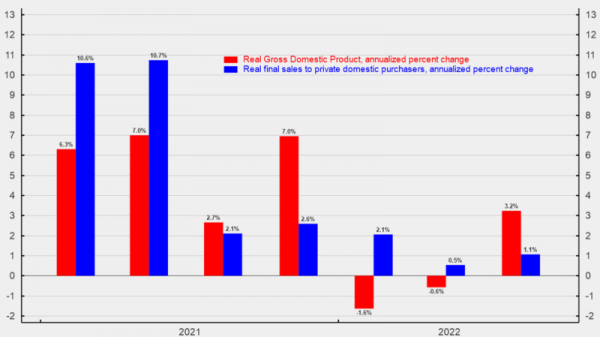

The S&P/TSX Venture Composite Index (INDEXTSI:JX) fell 2.63 percent on the week to close at 591.22 on Friday (November 8). Meanwhile, the S&P/TSX Composite Index (INDEXTSI:OSPTX) was up 0.43 percent to 24,890.68 and the CSE Composite Index (CSE:CSECOMP) climbed 1.24 percent to 146.64.
The US Bureau of Labor Statistics released October’s consumer price index (CPI) data on Wednesday (November 13), with figures showing that inflation has stalled. While the numbers were in line with analysts’ expectations, all items CPI was up 0.2 percent month-over-month for the fourth consecutive month following a decline of 0.1 percent in June.
On a yearly basis, all item inflation came in at 2.6 percent, slightly higher than September’s 2.4 percent. Minus the volatile food and energy categories, CPI was up 3.3 percent annually, well above the Federal Reserve target of 2 percent.
In remarks on Thursday (November 14) to the Dallas Regional Chamber, US Federal Reserve Chairman Jerome Powell said that while the economy is in a good place, he wasn’t in a hurry to make further interest rate cuts. Despite this, the majority of analysts are still predicting a 25-point cut when the Federal Open Markets Committee next meets on December 17 and 18.
The US dollar continued to see gains this week, adding further pressure to precious metals markets. Gold slipped another 4.56 percent this week to US$2,561.44 on Friday at 4:00 p.m. EST, while silver shed 3.43 percent to US$30.23. Copper was also down, dropping 5.9 percent to US$4.10 per pound on the COMEX. More broadly, the S&P GSCI (INDEXSP:SPGSCI) fell 2.19 percent to close at 527.18.
With the post-election surge coming to an end, equity markets were in retreat this week. The S&P 500 (INDEXSP:INX) fell 2.3 percent to finish at 5,870.63, the Nasdaq-100 (INDEXNASDAQ:NDX) dropped 3.67 percent to close Friday at 20,394.13 and the Dow Jones Industrial Average (INDEXDJX:.DJI) lost 1.39 percent to 43.445.00.
Find out how the five best-performing Canadian mining stocks performed against that backdrop.
Data for this article was retrieved at 4:00 p.m. EST on November 8, 2024, using TradingView’s stock screener. Only companies trading on the TSX, TSXV and CSE with market capitalizations greater than C$10 million are included. Companies within the non-energy minerals and energy minerals sectors were considered.
1. Canterra Minerals (TSXV:CTM)
Weekly gain: 150 percentMarket cap: C$27.92 millionShare price: C$0.10
Canterra Minerals is a critical mineral exploration company working to advance a portfolio of projects in Newfoundland and Labrador, Canada.
The past several months has seen the company focusing its efforts on its Buchans project located on the northern end of Beothuk Lake. The property has seen historic mining between 1935 and 1981. Canterra acquired the project in November 2023 as part of a package along with the Bobby’s Pond, Tulks Hill, Daniel’s Pond and Tulks South properties.
The primary target for Canterra at Buchans is the Lundberg deposit. According to a 2024 technical report, a 2019 mineral resource estimate for the deposit demonstrated indicated grades of 1.53 percent zinc, 0.64 percent lead, 0.42 percent copper, 5.69 grams per metric ton (g/t) silver and 0.07 g/t gold from 16.79 million metric tons of ore.
The most recent update from the site came on Wednesday when the company reported initial drill results from its maiden drill program. The company received assays from six of the eight holes, and highlighted one hole that returned grades of 0.74 percent copper, 3.92 percent zinc, 1.16 percent lead, 11.5 g/t silver and 0.16 g/t gold over a 60 meter interval starting from the surface. That interval also included an intersection of 26 meters near-surface grading 0.95 percent copper, 6.13 percent zinc, 1.63 percent lead, 13.9 g/t silver and 0.2 g/t gold.
Canterra said that the drill results show the potential for further expansion of the Lundberg deposit and provide a foundation for long-term development.
2. Class 1 Nickel and Technologies (CSE:NICO)
Weekly gain: 52.17 percentMarket cap: C$53.53 millionShare price: C$0.35
Class 1 Nickel and Technologies is an exploration and development company working to advance its Alexo-Dundonald project near Timmins, Ontario, Canada.
The nickel sulphide project is composed of 106 mining claims, 29 patents and 14 leases covering 3,370 hectares. The site is host to four nickel sulphide deposits including the past-producing Alexo and Alexo south mines.
On November 14, the company released an updated mineral resource estimate for Donaldson South which reported total indicated values of 31.6 million pounds of nickel, 1.06 million pounds of copper and 834,000 pounds of cobalt from 2.74 million metric tons of ore with grades of 0.52 percent nickel, 0.02 percent copper and 0.01 percent cobalt.
Class 1 has also updated the mineral resource estimates for two other deposits in 2024, and it included those in the release as well. It reported an indicated resource from Alexo South of 7.73 million pounds of nickel, 323,000 pounds of copper and 290,000 pounds of cobalt from 572,000 metric tons of ore. Additional indicated resources from Alexo North came in at 864,000 pounds of nickel, 95,000 pounds of copper and 38,000 pounds of cobalt from 42,600 metric tons of ore.
3. Euromax Resources (TSXV:EOX)
Weekly gain: 50 percentMarket cap: C$11.13 millionShare price: C$0.015
Euromax Resources is a development and exploration company working to advance its Ilovica-Shtuka copper project in Southeast Macedonia.
The advanced stage project is composed of two concession agreements that cover 17.1 square kilometers and hosts mineralized deposits of copper and gold.
The most recent feasibility study for the Ilovica-Shtuka project, released in 2016, demonstrated a sulphide mineral resource with measured and indicated quantities of 2.6 million ounces of gold and 1.2 billion pounds of copper, with additional oxide quantities of 280,000 ounces of gold.
Shares in Euromax saw gains this week after it announced on Wednesday that it had closed a non-brokered private placement of 118.49 million common shares for gross proceeds of C$1.78 million, a portion of which will go towards working capital for the project.
4. Gabriel Resources (TSXV:GBU)
Weekly gain: 50 percentMarket cap: C$12.56 millionShare price: C$0.015
Gabriel Resources is a precious metals explorer and developer focused on advancing its Rosia Montana gold project. Based in Transylvania, Romania, Rosia Montana is in a region that has seen significant historic mining. Covering 2,388 hectares, the site is host to a mid-to-shallow epithermal system containing deposits of gold and silver.
The most recent resource estimate from a 2012 technical report shows proven and probable quantities of 10.1 million ounces of gold and 47.6 million ounces of silver. Gabriel has invested more than US$760 million into Rosia Montana, but has undertaken little development at the site since the early 2010s, as Romania blocked further development.
In 2015, the company entered into arbitration through the World Bank’s International Center for Settlement of Investment Disputes (ICSID) over permitting at the site and suggested that Romania was in violation of bilateral investment treaties. On March 8, Gabriel issued a press release with an update saying that its case against Romania had been dismissed by the ICSID, which also awarded Romania US$10 million in legal fees and expenses. Gabriel said it would review the decision with its legal team and evaluate its options. While news of that decision caused Gabriel’s share price to plummet in March, it saw gains after closing the initial tranche of a US$5.58 million private placement on May 17.
The most recent update about the arbitration came on July 8, when the company announced it would be seeking an annulment of the ICSID award. The company said that the original decision was fatally flawed in multiple respects, including the disregarding of applicable law and multiple departures from fundamental rules and procedures.
5. KWG Resources (CSE:CACR)
Weekly gain: 50 percentMarket cap: C$19.09 millionShare price: C$0.015
KWG Resources is a chromite and base metals exploration company focused on advancements of its Ring of Fire assets in Northern Ontario, Canada. It does business as the Canadian Chrome Company.
Its assets consist of the Fancamp and Big Daddy claims, and the Mcfaulds Lake, Koper Lake and Fishtrap Lake properties. All properties are located within a 40 kilometer radius and are home to feeder magma chambers containing chromite, nickel and copper deposits.
KWG is currently working with local First Nations to improve transportation to the region through the development of road and rail links. The company announced on November 7 that it had signed a memorandum of agreement with AtkinsRealis Canada in its capacity as a contractor representing Marten Falls and Webequie First Nations.
The agreement will allow AtkinsRealis temporary access rights over some mineral exploration claims in support of work permits for an environmental assessment for the design, construction and operation of a multi-use all-season road between the proposed Marten Falls community access road and proposed Webequie supply road.
Once completed, the link will provide improved access to communities and mining companies in the region, a goal of KWG’s.
FAQs for Canadian mining stocks
What is the difference between the TSX and TSXV?
The TSX, or Toronto Stock Exchange, is used by senior companies with larger market caps, and the TSXV, or TSX Venture Exchange, is used by smaller-cap companies. Companies listed on the TSXV can graduate to the senior exchange.
How many companies are listed on the TSXV?
As of June 2024, there were 1,630 companies listed on the TSXV, 925 of which were mining companies. Comparatively, the TSX was home to 1,806 companies, with 188 of those being mining companies.
Together the TSX and TSXV host around 40 percent of the world’s public mining companies.
How much does it cost to list on the TSXV?
There are a variety of different fees that companies must pay to list on the TSXV, and according to the exchange, they can vary based on the transaction’s nature and complexity. The listing fee alone will most likely cost between C$10,000 to C$70,000. Accounting and auditing fees could rack up between C$25,000 and C$100,000, while legal fees are expected to be over C$75,000 and an underwriters’ commission may hit up to 12 percent.
The exchange lists a handful of other fees and expenses companies can expect, including but not limited to security commission and transfer agency fees, investor relations costs and director and officer liability insurance.
These are all just for the initial listing, of course. There are ongoing expenses once companies are trading, such as sustaining fees and additional listing fees, plus the costs associated with filing regular reports.
How do you trade on the TSXV?
Investors can trade on the TSXV the way they would trade stocks on any exchange. This means they can use a stock broker or an individual investment account to buy and sell shares of TSXV-listed companies during the exchange’s trading hours.
Article by Dean Belder; FAQs by Lauren Kelly.
Securities Disclosure: I, Dean Belder, hold no direct investment interest in any company mentioned in this article.
Securities Disclosure: I, Lauren Kelly, hold no direct investment interest in any company mentioned in this article.

























